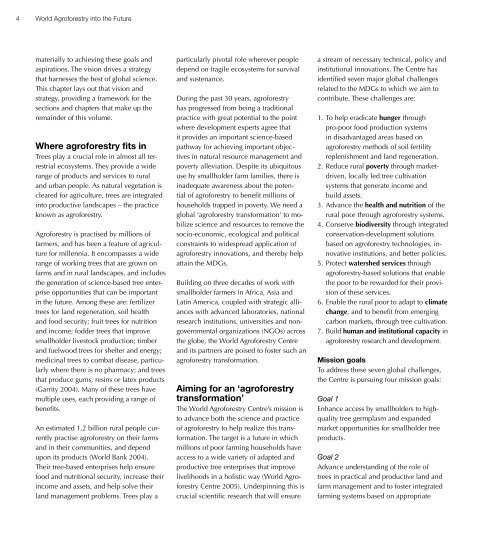The challenge of HIV/AIDS: Where does agroforestry fit in? - World ...
The challenge of HIV/AIDS: Where does agroforestry fit in? - World ...
The challenge of HIV/AIDS: Where does agroforestry fit in? - World ...
Create successful ePaper yourself
Turn your PDF publications into a flip-book with our unique Google optimized e-Paper software.
4<strong>World</strong> Agr<strong>of</strong>orestry <strong>in</strong>to the Futurematerially to achiev<strong>in</strong>g these goals andaspirations. <strong>The</strong> vision drives a strategythat harnesses the best <strong>of</strong> global science.This chapter lays out that vision andstrategy, provid<strong>in</strong>g a framework for thesections and chapters that make up therema<strong>in</strong>der <strong>of</strong> this volume.<strong>Where</strong> agr<strong>of</strong>orestry <strong>fit</strong>s <strong>in</strong>Trees play a crucial role <strong>in</strong> almost all terrestrialecosystems. <strong>The</strong>y provide a widerange <strong>of</strong> products and services to ruraland urban people. As natural vegetation iscleared for agriculture, trees are <strong>in</strong>tegrated<strong>in</strong>to productive landscapes – the practiceknown as agr<strong>of</strong>orestry.Agr<strong>of</strong>orestry is practised by millions <strong>of</strong>farmers, and has been a feature <strong>of</strong> agriculturefor millennia. It encompasses a widerange <strong>of</strong> work<strong>in</strong>g trees that are grown onfarms and <strong>in</strong> rural landscapes, and <strong>in</strong>cludesthe generation <strong>of</strong> science-based tree enterpriseopportunities that can be important<strong>in</strong> the future. Among these are: fertilizertrees for land regeneration, soil healthand food security; fruit trees for nutritionand <strong>in</strong>come; fodder trees that improvesmallholder livestock production; timberand fuelwood trees for shelter and energy;medic<strong>in</strong>al trees to combat disease, particularlywhere there is no pharmacy; and treesthat produce gums, res<strong>in</strong>s or latex products(Garrity 2004). Many <strong>of</strong> these trees havemultiple uses, each provid<strong>in</strong>g a range <strong>of</strong>bene<strong>fit</strong>s.An estimated 1.2 billion rural people currentlypractise agr<strong>of</strong>orestry on their farmsand <strong>in</strong> their communities, and dependupon its products (<strong>World</strong> Bank 2004).<strong>The</strong>ir tree-based enterprises help ensurefood and nutritional security, <strong>in</strong>crease their<strong>in</strong>come and assets, and help solve theirland management problems. Trees play aparticularly pivotal role wherever peopledepend on fragile ecosystems for survivaland sustenance.Dur<strong>in</strong>g the past 30 years, agr<strong>of</strong>orestryhas progressed from be<strong>in</strong>g a traditionalpractice with great potential to the po<strong>in</strong>twhere development experts agree thatit provides an important science-basedpathway for achiev<strong>in</strong>g important objectives<strong>in</strong> natural resource management andpoverty alleviation. Despite its ubiquitoususe by smallholder farm families, there is<strong>in</strong>adequate awareness about the potential<strong>of</strong> agr<strong>of</strong>orestry to bene<strong>fit</strong> millions <strong>of</strong>households trapped <strong>in</strong> poverty. We need aglobal ‘agr<strong>of</strong>orestry transformation’ to mobilizescience and resources to remove thesocio-economic, ecological and politicalconstra<strong>in</strong>ts to widespread application <strong>of</strong>agr<strong>of</strong>orestry <strong>in</strong>novations, and thereby helpatta<strong>in</strong> the MDGs.Build<strong>in</strong>g on three decades <strong>of</strong> work withsmallholder farmers <strong>in</strong> Africa, Asia andLat<strong>in</strong> America, coupled with strategic allianceswith advanced laboratories, nationalresearch <strong>in</strong>stitutions, universities and nongovernmentalorganizations (NGOs) acrossthe globe, the <strong>World</strong> Agr<strong>of</strong>orestry Centreand its partners are poised to foster such anagr<strong>of</strong>orestry transformation.Aim<strong>in</strong>g for an ‘agr<strong>of</strong>orestrytransformation’<strong>The</strong> <strong>World</strong> Agr<strong>of</strong>orestry Centre’s mission isto advance both the science and practice<strong>of</strong> agr<strong>of</strong>orestry to help realize this transformation.<strong>The</strong> target is a future <strong>in</strong> whichmillions <strong>of</strong> poor farm<strong>in</strong>g households haveaccess to a wide variety <strong>of</strong> adapted andproductive tree enterprises that improvelivelihoods <strong>in</strong> a holistic way (<strong>World</strong> Agr<strong>of</strong>orestryCentre 2005). Underp<strong>in</strong>n<strong>in</strong>g this iscrucial scientific research that will ensurea stream <strong>of</strong> necessary technical, policy and<strong>in</strong>stitutional <strong>in</strong>novations. <strong>The</strong> Centre hasidentified seven major global <strong>challenge</strong>srelated to the MDGs to which we aim tocontribute. <strong>The</strong>se <strong>challenge</strong>s are:1. To help eradicate hunger throughpro-poor food production systems<strong>in</strong> disadvantaged areas based onagr<strong>of</strong>orestry methods <strong>of</strong> soil fertilityreplenishment and land regeneration.2. Reduce rural poverty through marketdriven,locally led tree cultivationsystems that generate <strong>in</strong>come andbuild assets.3. Advance the health and nutrition <strong>of</strong> therural poor through agr<strong>of</strong>orestry systems.4. Conserve biodiversity through <strong>in</strong>tegratedconservation-development solutionsbased on agr<strong>of</strong>orestry technologies, <strong>in</strong>novative<strong>in</strong>stitutions, and better policies.5. Protect watershed services throughagr<strong>of</strong>orestry-based solutions that enablethe poor to be rewarded for their provision<strong>of</strong> these services.6. Enable the rural poor to adapt to climatechange, and to bene<strong>fit</strong> from emerg<strong>in</strong>gcarbon markets, through tree cultivation.7. Build human and <strong>in</strong>stitutional capacity <strong>in</strong>agr<strong>of</strong>orestry research and development.Mission goalsTo address these seven global <strong>challenge</strong>s,the Centre is pursu<strong>in</strong>g four mission goals:Goal 1Enhance access by smallholders to highqualitytree germplasm and expandedmarket opportunities for smallholder treeproducts.Goal 2Advance understand<strong>in</strong>g <strong>of</strong> the role <strong>of</strong>trees <strong>in</strong> practical and productive land andfarm management and to foster <strong>in</strong>tegratedfarm<strong>in</strong>g systems based on appropriate




![MNC_00_Modau [Compatibility Mode].pdf](https://img.yumpu.com/51432208/1/190x146/mnc-00-modau-compatibility-modepdf.jpg?quality=85)











